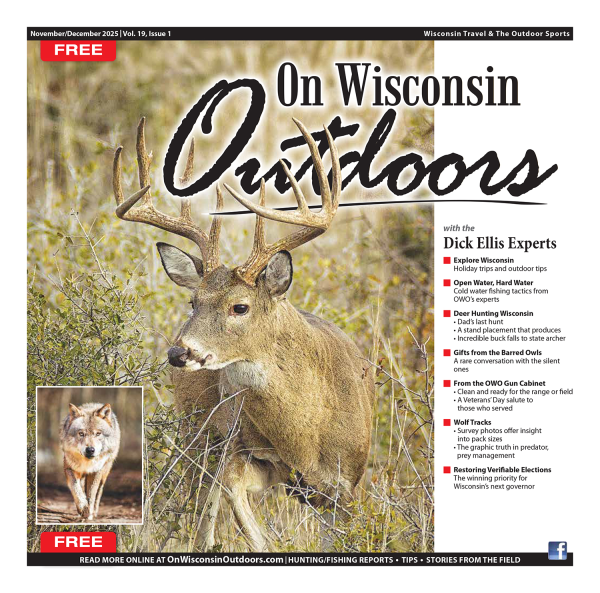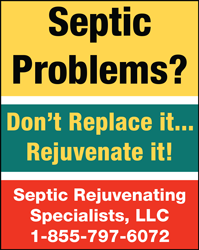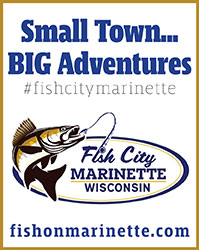DNR Weekly News Update for September 24, 2019
Published - September 24, 2019 by the Central Office
DNR Confirms Five Deer in Crawford and Richland Counties Died from EHD
Contact(s): Bret Owsley, Wildlife Management District Supervisor, 920-210-2451, bret.owsley@wisconsin.gov

In an effort to help keep Wisconsin's deer herd healthy, state wildlife biologists are asking people to report sick or dead deer.Photo credit: DNR
EHD, a Disease with No Threat to Humans Can be Fatal in Deer, Though Impacts to Deer Populations are Short-lived
MADISON, Wis. - State wildlife officials have confirmed that tissue samples collected from three deer in Crawford County and two deer from Richland County have tested positive for the virus that causes epizootic hemorrhagic disease, or EHD. Department of Natural Resources staff confirmed the occurrence of the disease after citizens in Crawford County reported recent observations of small groups of dead deer.
In addition to the three confirmed cases, wildlife staff suspect approximately 100 animals have died from EHD in Crawford County as of Sept. 20, based on clinical signs and proximity to other deer that have tested positive for the EHD virus. Staff members are following up on additional, unconfirmed reports of dead deer in Crawford County. EHD also contributed to the death of a fawn being monitored as part of the Southwest Wisconsin Deer and Predator Research Project in Iowa County. No additional suspect cases have been reported from Iowa County.
DNR staff members are also investigating reports of groups of dead deer from surrounding counties, and results from deer sampled in Sauk County are expected within the next week. The virus that causes EHD, epizootic hemorrhagic disease virus is a relatively common virus carried by midges, small flies, also known as biting gnats or no-see-ums. The EHD virus does not infect humans, according to health specialists. People are not at risk when handling infected deer, eating venison from infected deer, or being bitten by infected midges.
EHD can be fatal, especially in deer populations that have limited exposure to the virus, such as in Wisconsin. When deer die of EHD, they typically die within seven days of infection. Localized effects on deer numbers can vary in scale. Wisconsin saw one confirmed case with no additional or suspect cases in 2017. In 2012, an EHD outbreak was suspected of killing approximately 380 deer. At that time, most deaths were reported in Columbia and Dane counties.
EHD is prevalent across the southern and western United States, occasionally showing up in the Midwest. This year, outbreaks of EHD have been reported in Iowa and Indiana, and Minnesota confirmed the disease in wild deer for the first time. The disease is typically short-lived as the flies that transmit the disease die with the first hard frost.
"We are fortunate that the public is tuned into our deer and was quick to report these small pockets of infection mortality," said DNR Wildlife Management Southern District Supervisor Bret Owsley. "We hope the public will continue reporting observations of sick or dead deer. These observations will help us more clearly understand the geographic distribution and number of deer affected by this disease. This will be valuable information to inform management decisions for future years and provide a better understanding of the overall impact of the disease on our deer population."
Individuals who observe deer exhibiting the following signs are encouraged to report their observations to the DNR:
- Excessive salivation or foaming around the nose and mouth;
- Appearing weak and approachable by humans; or
- In or near water sources. They will often lay in water to cool down or drink.
Wildlife officials say that deer carcasses can be left on the landscape to decompose as the virus does not survive. The DNR will not be collecting or removing deer suspected of having died from EHD.
To report a first-hand observation of a single dead deer found near water or groups of dead deer, contact a county wildlife biologist. Fresh samples need to be collected within a day or two of death to be useful for detecting the virus. Please be prepared to provide details about the condition of the deer, the exact location where the deer was observed, and the condition of any carcasses. To learn more about EHD, visit the DNR website and search for "wildlife health." Then click on "diseases and conditions."
________________________
Collared Deer are Legal to Harvest During Fall Hunting Season
Contact(s): AnnaKathryn Kruger, Office of Applied Science Communications Coordinator, 608-438 4642 annakathryn.kruger@wisconsin.gov

Collared deer are legal to hunt with a standard Wisconsin hunting license and tags.Photo credit: Jerry Davis
MADISON, Wis. - During the 2019 hunting season, hunters may spot deer that are equipped with radio collars. Collared deer are part of a mortality study in the Wisconsin Department of Natural Resources and are legal to hunt with a standard Wisconsin hunting license and tags.
The DNR Office of Applied Science is conducting a five-year mortality study called the Southwest Wisconsin Chronic Wasting Disease, Deer, and Predator Project. Researchers are investigating factors like CWD, predation and hunter harvest, and specifically to what degree these affect survivorship in deer. So far, the project crew has put GPS-enabled collars on 548 deer in Grant, Iowa and Dane counties.
"One of our study objectives is to determine what proportion of our deer herd is harvested each year, and how exactly that differs according to how old the deer is, between bucks and does and between deer that are CWD-infected and those that are not," said DNR Deer Research Scientist Daniel Storm. "That objective depends on hunters essentially treating collared deer like any other deer when deciding whether or not to harvest."
Deer that are collared as part of the Southwest CWD, Deer, and Predator study are legal to harvest. Standard licensing and harvest regulations apply to collared deer just as they do to uncollared deer. Anyone who harvests a collared deer is asked to call the number on the collar so that a crew member can retrieve it. The number to call is 608-935-1940.
The DNR recommends testing for CWD for both collared and uncollared deer. CWD is a transmissible type of spongiform encephalopathy that causes fatal brain and nervous system degeneration in ungulate species like deer, elk, and moose. CWD testing is typically only done post-mortem. To better understand CWD in Wisconsin, the DNR needs to test as many deer as possible for the disease. To that end, getting deer tested is an important step. For more information, visit dnr.wi.gov and search keyword "CWD sampling."
________________________
Fall Festivals and Color Hikes at Wisconsin Recreational Properties
Contact(s): Paul Holtan, DNR Office of Communications, 608-235-2126 or paul.holtan@wisconsin.gov

Hayrides are one of the popular events at the MacKenzie Center Fall Festival which this year is Oct. 5.Photo credit: DNR
[EDITOR'S ADVISORY: This news release has been updated to add an event Oct. 6 at Pattison State Park.]
MADISON, Wis. - The Autumnal equinox this week is ushering in fall and colors are already turning in northern Wisconsin. People looking for opportunities to take in the colors will have multiple opportunities beginning this weekend and running through early November.
Fall festivals kick off Saturday, Sept. 28 at Copper Falls with arts and crafts, apple cider pressing, pumpkin carving and more. The Kettle Moraine State Forest Southern Unit is hosting fall color bike rides on the John Muir Trails. Roche-a-Cri will have hayrides and s'mores by the campfire.
Also on Sept. 28, Lakeshore State Park is holding SturgeonFest with River Edge Nature Center, where for a small fee, families can sponsor and hand release a small sturgeon into Lake Michigan. In addition, Governor Thompson State Park is holding a fall festival Saturday and Sunday, Sept. 28-29.
Throughout October and into November there will be multiple opportunities for color hikes as well as night hikes along trails lit by jack-o-lanterns or other luminaries. The weekend of Oct. 12-13, Horicon Marsh Education and Visitor Center is holding an Archaeological Festival with a buck skinners encampment, atlatl throwing, fire-starting, artifacts, a drum circle, speakers, vendors and more.
The MacKenzie Center will hold its Fall Festival on Oct. 5 with chances for visitors to participate in many activities including archery, compass skills, geocaching, wildlife tours, fire building, hiking, a hay bale maze, gunny sack races, face painting, scarecrow making, hayrides and much more. The center is currently in need of additional volunteers for the festival. Anyone interested in helping should send an email to MCeventvolunteers@gmail.com.
Several parks also offer Halloween-themed events with costumed revelers and visits from "non-scary" costumed wild creatures.
Events at state parks are generally free, but vehicles entering most park and forest properties are required to have a current Wisconsin State Parks daily or annual admission sticker.
For a complete listing of events, search the Wisconsin Department of Natural Resources website for "Get Outdoors."
Saturday, Sept. 28
- Copper Falls State Park - Fall Fest at Copper Falls State Park
- Kettle Moraine State Forest - Southern Unit - Fall Color Festival Bike Rides on the John Muir Trails
- Lakeshore State Park - SturgeonFest with RiverEdge Nature Center
- Roche-A-Cri State Park - Fall Festival
Saturday and Sunday, Sept. 28-29
Saturday, Oct. 5
Sunday, Oct. 6
Saturday, Oct. 12
- Big Foot Beach State Park - October Illuminated Night Hike
- Harrington Beach State Park - Fall Night Hike
- Rib Mountain State Park - Fall Color Hike
Saturday and Sunday, Oct. 12-13
Sunday, Oct. 13
Wednesday, Oct. 16
Friday, Oct. 18
Saturday, Oct. 19
- Devil's Lake State Park - Fall Photo Hike
- George W. Mead Wildlife Area - Spooktacular & Food Drive
- High Cliff State Park - Halloween Campground Walk
- Kettle Moraine State Forest - Northern Unit - Halloween Nature Hikes
- Merrick State Park - "Not So Spooky" Hike
- Mirror Lake State Park - Halloween Mystery Torchlight Hike
- Richard Bong State Recreation Area - Eco-Halloween Hike
Sunday, Oct. 20
Wednesday, Oct. 23
Saturday, Oct. 26
Sunday, Oct. 27
Saturday, Nov. 2
For all events visit the DNR website and search Get Outdoors
________________________
New Statewide Aquatic Invasive Species Management Plan Approved and Available to the Public
Contact(s): Bob Wakeman, DNR AIS program coordinator, 262-574-2149, Robert.Wakeman@wisconsin.gov or Tim Campbell, AIS outreach specialist, 608-265-3727, Timothy.Campbell@Wisconsin.gov

The newly updated AIS management plan includes strategies for controlling many aquatic invasive species including this water hyacinth plant.Photo credit: DNR
MADISON, Wis. - Wisconsin's recently revised aquatic invasive species (AIS) management plan is now final and available for use by the public after receiving approvals from the National Aquatic Nuisance Species Task Force. Wisconsin last completed an AIS management plan in 2002.
"In the last 17 years since the approval of the original plan, we have new species that we are concerned about, new pathways of invasion in Wisconsin and new tools to help us manage the undesirable impacts of aquatic invasive species," said DNR AIS Program Coordinator Bob Wakeman. "The new plan incorporates these approaches and concerns into our management plan so that we will be using the most effective methods possible to manage aquatic invasive species."
Wisconsin's AIS management plan serves multiple purposes, including maintaining Wisconsin's eligibility for funding and directing the AIS efforts of the DNR and partner groups. The new plan also introduces an invasion pathway management approach that will help Wisconsin systematically limit how invasive species move into and throughout Wisconsin.
"This plan represents a progression of AIS management in Wisconsin, one where we move from establishing an AIS management program, to one where we are growing and refining our existing program to reduce invasion risk and impacts further," Wakeman said.
The revised plan is the result of years of work by a core team led by the DNR, the University of Wisconsin Division of Extension, UW Sea Grant, and nongovernmental organizations that have a role in AIS management.
"All of our partners contributed a great deal to the development of our new plan," said UW Extension and UW Sea Grant AIS Outreach Specialist Tim Campbell, a lead author of the plan. "We hope that this collaborative approach will lead to everyone in Wisconsin playing a significant role in preventing the spread of and managing the impacts of AIS."
The plan can be accessed by visiting the DNR website to and searching for "Aquatic invasive species efforts" page. Printed copies are available upon request by emailing DNRAISinfo@wisconsin.gov.
________________________
Read more: Previous Weekly News











